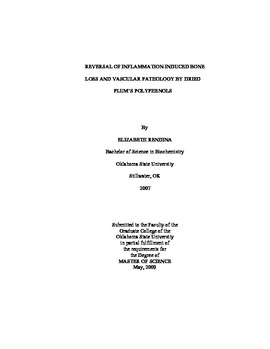| dc.contributor.advisor | Smith, Brenda J. | |
| dc.contributor.author | Rendina, Elizabeth | |
| dc.date.accessioned | 2014-04-15T22:01:30Z | |
| dc.date.available | 2014-04-15T22:01:30Z | |
| dc.date.issued | 2009-05-01 | |
| dc.identifier.uri | https://hdl.handle.net/11244/9268 | |
| dc.description.abstract | Recent studies have indicated that a relationship exists between the pathophysiology of osteoporosis and cardiovascular disease. Chronic elevation of inflammatory mediators, such as tumor necrosis factor (TNF)-? and members of the TNF receptor superfamily of proteins such as the ligand for receptor activator for nuclear factor-κB (RANKL) and its soluble decoy receptor, osteoprotegerin (OPG), have been proposed as playing a pivotal role in concurrent osteoporosis and atherosclerosis. Previously, our laboratory has shown that dietary supplementation with dried plum and its polyphenols down-regulate inflammatory mediators such as TNF-? and RANKL in vitro and in models of gonadal hormone deficiency. The aim of the current study was to induce simultaneous occurrence of bone loss and vascular pathology by chronic low grade inflammation, and to determine the protective effect dried plum's polyphenols exert in vivo. This study utilized 12-wk-old C57BL/6 male mice (n=192) that were implanted with pellets designed to deliver either 0.0 or 0.1 mg LPS/kg body weight/d and randomly assigned to one of the following dietary treatments: Placebo-control (AIN-93M) diet, LPS (Control) , control diet supplemented with low (LDP) or high dose dried plum (HDP) (low = 5% or high = 25%, w/w DP added), control diet with comparable dose of polyphenolic compounds as low (LPP) and high dose dried plum (HPP), or simvastatin (Statin) as a positive control (25 mg/kg diet). All dietary treatments started after baseline (4 weeks) and were maintained for either 2 or 6 weeks. We reported no inflammation-induced changes in bone mass, trabecular or cortical microarchitecture, and bone biomechanical properties at baseline, 2 or 6 weeks. However, we did observe cardiovascular pathology indicative of microvascular disease in the animals receiving LPS on the control diet. After 6 weeks of treatment, dried plum and its polyphenols were able to attenuate the vascular pathology. The results obtained in this study suggest that in this study the cardiovascular system was more responsive to the LPS and thus the dietary treatments compared to the skeletal systemthe cardiovascular system may be more sensitive to chronic-low grade inflammation and dietary responsiveness relative to the skeletal system. Further investigation should be carried out to determine if these results are reproducible, and if so, what these findings reveal about inflammation-induced vascular changes. | |
| dc.format | application/pdf | |
| dc.language | en_US | |
| dc.publisher | Oklahoma State University | |
| dc.rights | Copyright is held by the author who has granted the Oklahoma State University Library the non-exclusive right to share this material in its institutional repository. Contact Digital Library Services at lib-dls@okstate.edu or 405-744-9161 for the permission policy on the use, reproduction or distribution of this material. | |
| dc.title | Reversal of Inflammation-Induced Bone Loss and Vascular Pathology by Dried Plum's Polyphenols | |
| dc.type | text | |
| dc.contributor.committeeMember | Clarke, Stephen L. | |
| dc.contributor.committeeMember | Lucas, Edralin A. | |
| osu.filename | Rendina_okstate_0664M_10322.pdf | |
| osu.college | Human Environmental Sciences | |
| osu.accesstype | Open Access | |
| dc.description.department | Department of Nutritional Sciences | |
| dc.type.genre | Thesis | |
